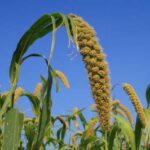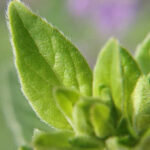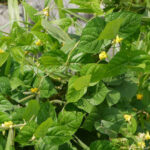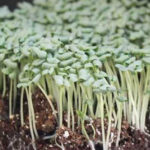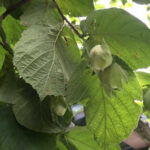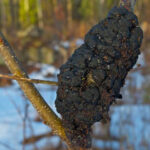One of the most beloved plants in the Southeastern United States is the pecan tree. Pecans are plentiful there, with over 500 different pecan cultivars. Some are bred to survive in the sweltering southern heat, while others can survive winters in the central US.
While pecan trees are forest trees, they can be grown at home, especially if you have room for them. Maybe you’re interested in planting pecan trees to make your own pecan tree grove. Perhaps you’re interested in just one so you can harvest and enjoy the delicious buttery pecan nut.
Whatever your reason, know that you can grow pecan varieties at home. As long as you give the tree what it needs, you’ll grow an annual crop of pecans that satisfy hunger year after year. Grow one tree or many trees… whatever works best for your situation!
Quick Care Guide
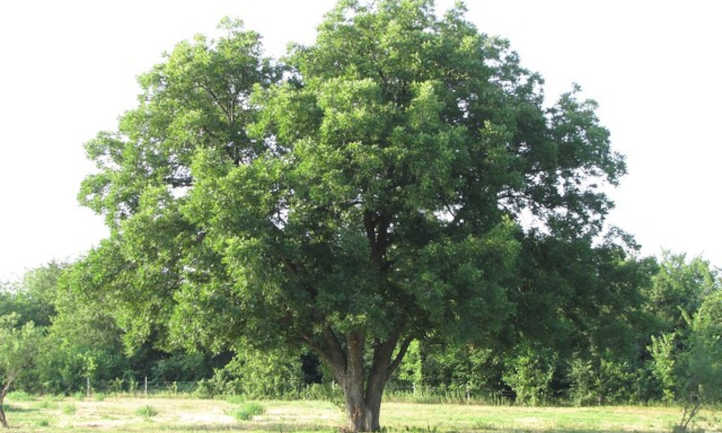
| Common Name(s) | Pecan, pecan tree |
| Scientific Name | Carya illinoinensis |
| Days to Harvest | 150 days from fruit to harvest |
| Light | Full sun |
| Water | 2 inches per week |
| Soil | Average, moist, well-draining |
| Fertilizer | Soil drench 1 to 2 times annually |
| Pests | Squirrels, pecan weevils, yellow aphids, ravens/crows |
| Diseases | Pecan scab, root knot nematode |
All About Pecan Trees

The pecan tree (Carya illinoinensis) is a deciduous tree native to the Mississippi River Valley in the Southern US and Northern Mexico. The word “pecan” is Algonquin and refers to the nuts from hickory, walnut, and pecan trees. In the late 1800s, colonists bred pecan trees for commercial production.
Pecan trees are large with a spread of up to 75 feet, and grow up to 130 feet tall. They have an up-to 7-foot trunk diameter. The pinnate pecan leaves grow alternately on branches. Each leaf is 2 to 4 inches long, and about an inch wide. The tree grows a long taproot with feeder roots that reach deeper than 10 feet below the ground.
Trees grow pecans after they’ve had at least 5 years to mature. Sometimes they need 7 years. Then they grow pecans annually between June and September, which are harvested between October and December. In a process called alternate bearing, pecan trees produce more in alternate years. When there are fewer pecans, they may be eaten by wildlife before humans get to them.
The “nut” of pecan is a drupe – a fruit surrounded by a hard shell. It has a tough, green outer shell that opens as the fruit dries, exposing the striped black and brown inner shell. Within are the tasty nuts used in making pecan pie, candied pecans, and pecan-crusted meats.
Pecans carry out cross-pollination via male and female flowers that grow on the same tree. Female flowers develop on the new growth of a pecan tree, while male flowers bloom on last years’ branches. Depending on the type of tree, either female or male flowers mature first. Then they are pollinated by wind and bees. To have the best results and the best fruit-bearing trees, it’s recommended to grow more than one tree in an area.
Planting
You can find pecans in native plant nurseries in the Southern US, or via online distributors. Plant both bare root trees and container-grown trees in late winter to early spring. Consider an Air Pot which is specialized for air pruning roots, as opposed to a large container. Do not plant them in the summer as the ground will be too warm and burn the roots. For bare-root planting, space at least 60 feet apart, and dig a planting hole that is about two times wider than the size of the root ball. Provide well-drained soils for each tree. Keep trees widely planted. Allow the top layer of soil to sit in a small mound above the top of the planting hole.
When you remove the tree from the nursery pot, check to ensure the roots are not bound together. Use a hand saw to take off the bottom portion of the planting if they are bound up and then cut gently into the soil mass in a cross at the base, ensuring the taproot can be planted straight into the ground. Gently arrange the roots in the planting hole, and begin filling them with water until the hole is half full. Then add soil. Water the young pecan trees in.
For a container-grown pecan, follow the same preparation process for unbinding the roots and straightening the tap root. Find a container that is large enough to accommodate the taproot and feeder roots. To ensure proper growth on both container and bare root trees, paint the trunk with white latex paint. This keeps out squirrels, birds, and cold damage that could reduce nut production in later years. Add a three-inch layer of pine needle or wood shaving mulch keeping the mulch away from the trunk diameter.
Care
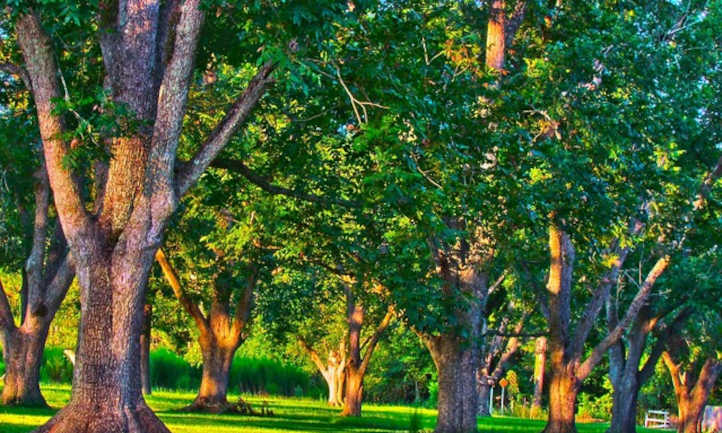
With the right patience and care, you’ll plant trees and have mature trees in about 5 to 7 years. Let’s cover some of the basics to help you grow a mature pecan tree that bears delicious pecan fruit.
Sun and Temperature
Pecan trees enjoy full sun, at about 6 to 8 hours of full, direct light per day. Pecans are well known in USDA zones 5 through 9 and prefer temperatures that are temperate to warm. They appreciate moderately cool winters at 40 to 45 degrees Fahrenheit. Established trees can handle 20 degrees, and sometimes down to 0 degrees. A mature tree has an easier time withstanding snap freezes and winter storms. Young trees are more susceptible to extremes and can die in the harsh cold. They’ll need extra protection when temperatures dip below 40 degrees. Hot summers with high humidity are preferred as well. To protect young trees in the cold, wrap the tree trunk with a frost blanket or with cardboard affixed with duct tape. Chicken wire stuffed with dry leaves also works. Some experts recommend wrapping string lights around the cover to add extra warmth. Freeze damage below their preferred range will cause blossom and fruit drop.
Water and Humidity
Give your new trees at least 10 to 15 gallons of water per week for proper tree growth. Water in the morning, and provide this via drip irrigation or soaker hoses placed in a wide ring around the base of the tree trunk. Do not overwater, as constantly wet soil will cause rot in the root system. Soil moisture should be allowed to dry between watering. In the summer, give mature trees more water to help them bear nuts. If there has been a great deal of moisture in the dormant season (winter) do not water.
Soil
Pecan trees tolerate many different soil types. One thing they appreciate is adequate soil moisture retention. In container-grown situations, an addition of peat moss or some other water-retention material helps. That’s why an average potting mix is a great amendment for your planting hole. The best pH range for these trees is between 6.5 and 7.0. Well-drained soil is a must as well.
Fertilizing
When you have large trees, fertilize 2 times per year to assist in growth and pollination. Pecan trees like a small amount of fertilizer applied once in the second year of growth – the year after they’ve been planted. A balanced fertilizer in granular or liquid form should be soaked into the soil in June, just before fruiting. There are specific fertilizers developed for pecan trees that contain the micronutrients they require. Alternatively, a zinc sulfate powder can be applied along with your regular choice at the time of fertilization to young and mature trees, since they require zinc to develop properly. Look for a balanced fertilizer with a 10-10-10 NPK. Established trees enjoy fertilization in March and then again in June.
Pruning
Pecan trees, like most trees, do best when they’re adequately pruned in the first five years. Prune back the top third of the branches when you first plant your tree. In the first growing season, prune away all but one of the leader branches. Leader branches are usually those in line with the trunk. Prune established trees in late winter before spring buds form. Remove branches that angle up more than 45 degrees. You can prune in summer, but only do so when it’s necessary. Summer pruning invites disease and pests into the cut areas. Prunings in winter reduce pest pressure.
Propagation
Pecan trees propagate easiest through grafting. They can also be grown from seed like other trees that bear drupes. You can graft branches onto other cultivars, but it’s not completely necessary. Some graftings may help improve nut quality and production. Seed-grown trees will be an exact clone of the tree in the same family.
There are many different ways to graft a pecan, but we’ll just cover bark grafting here. Remove a healthy branch (about 1 inch of trunk diameter) with a clean cut from a sharp knife. Take off the bark at the bottom of the branch and cut the base diagonally. Then, place the cut piece under the bark of the rootstock. Hammer it in and wrap it. In 4 to 6 weeks new buds should form.
You can remove a pecan seedling easily from the ground below your tree and transplant it in a starter pot. Nurture it and re-pot it as needed, then transplant it.
Harvesting and Storing
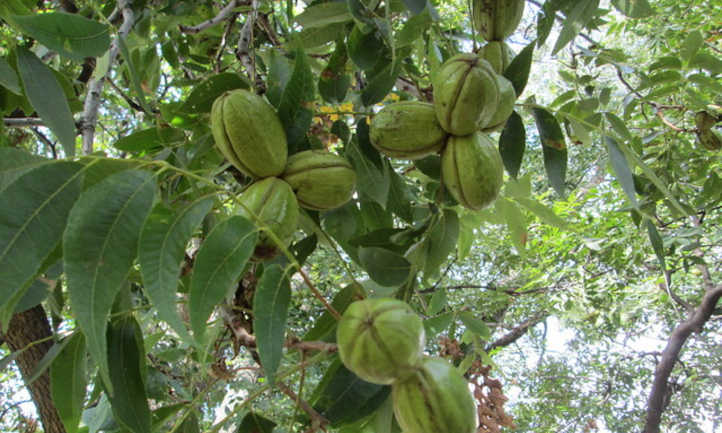
Harvesting operations are the best part of growing pecan. Those in the pecan industry have methods for harvesting many pecan trees. But let’s talk about harvesting from pecan production at home.
Harvesting
Pecans drop nuts in the fall just before their leaves drop. They fall with the green husk on, and as it dries, it pops open. The inner nut and its outer shell are then exposed. As a result, harvesting pecans is just a matter of finding the right pecans on the ground. You can also knock them from the tree, but you’ll find that’s much harder especially when you’re vying with height and nearby squirrels, crows, and ravens.
Collect undamaged and recently dropped pecans. Hull any nuts with husks remaining. If the hull doesn’t remove easily, it’s likely ripeness has not set in. After you collect the pecans, cure them in an area with good air circulation and low light. Spread them in a single layer on a baking sheet or plastic lid. Provide them with a small fan and stir them once daily. Ripe pecans easily separate from their inner shell.
Storing
One way to extend the shelf life of pecans is to put them in a jar or plastic freezer bag in the refrigerator or freezer. Unshelled pecans last this way for 2 or more years. Shelled ones will keep 1 year or more. You can keep some nearby on a counter in an airtight container for several months. Always taste your pecans for freshness before adding them to dishes.
Troubleshooting
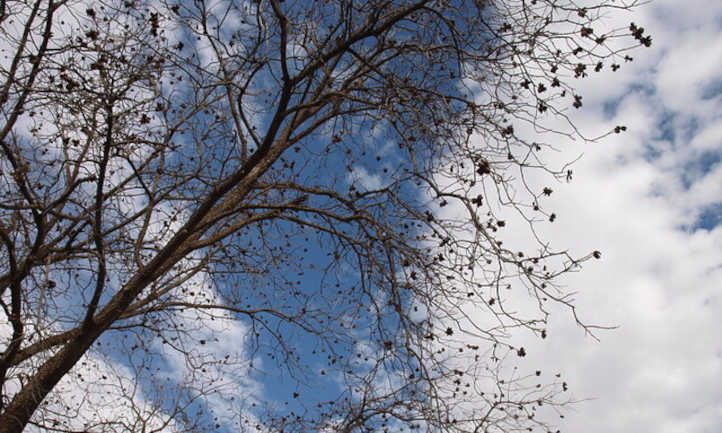
Pecans are so tasty, it’s likely you won’t be the only one interested in the fruit. Let’s discuss a few issues and “friends” you might face when growing them.
Growing Problems
If you badly damaged the root system of a pecan tree when you planted it, the young tree could have trouble finding nutrients. Broken roots can lead to improper moisture uptake too, causing the tree to wilt. One way to ensure the tree is taking in proper nutrient content is to do a leaf analysis. Taking leaf samples over time will help you determine the type of nutrient deficiencies (if any) and the remediation needed. Leaf analysis can be done through your local agricultural extension office.
If you plant your tree in a spot without adequate sun, or in a place where moisture doesn’t drain properly, it could experience several different problems, and the potential for fungal attacks is higher. Replanting can help in young trees, while older trees may need assistance from an arborist.
Pests
Squirrels and birds like ravens and crows will eat your pecans before you can get to them sometimes, and squirrels can do a lot of damage to a pecan tree in a short period. In an established tree, this isn’t much of a problem and the worst-case scenario is that you’ll only be able to collect pecans in more abundant seasons. Mothballs in mesh bags hung on branches may keep them away. Electronic sonic deterrents work too, but remember to check the batteries.
Weevils are a problem for pecan production. They’ll burrow with their small proboscis into the nutshell and eat the flesh within. Beneficial nematodes applied at the base of the tree will stop weevils in their larval stage, preventing them from even maturing to the point of seeking nuts. Apply them between September and December while the weevil larvae are overwintering. There are also fungal pesticides that can be applied at the base of the tree weekly. These attack crop pest larvae.
Yellow aphids feed on the sap of pecan leaves and tree matter. They spread honeydew in a yellow film around pecan orchards. You’ll notice this first in spring when they’re most active. You can introduce parasitic wasps and ladybugs to consume them. You can also plant cover crops like alfalfa and hairy vetch to deter them. Insecticidal soaps, horticultural oils, and neem oil can be used to kill them off.
Root-knot nematodes are parasites that cause galls and knotting on roots. They can be easily treated with beneficial nematodes you may have applied for the control of weevils.
Diseases
Pecan scab is well known among pecan growers. It is a fungal disease that looks like rot spreading along pecan drupes. It can defoliate the tree and make pecans much smaller than they would be without the disease. There is no eliminating pecan scab, only managing it. There are plenty of cultivars bred for scab resistance. Amling, Gafford, and Syrup Mill are a few varieties with excellent scab resistance. Otherwise, keep your orchard free of debris, and you won’t have so much scab that you’re unable to produce fruit.
Frequently Asked Questions

Q: How long does it take for a pecan tree to bear fruit?
A: It takes 5 to 7 years for a tree to mature, and then about 5 months from flower to fruit.
Q: Are pecan trees hard to grow?
A: No! They’re happy almost anywhere within their zones.
Q: Do you need two pecan trees to get nuts?
A: Cross-pollination happens on just one tree, but allowing that process to occur between two different trees will yield better fruit.


